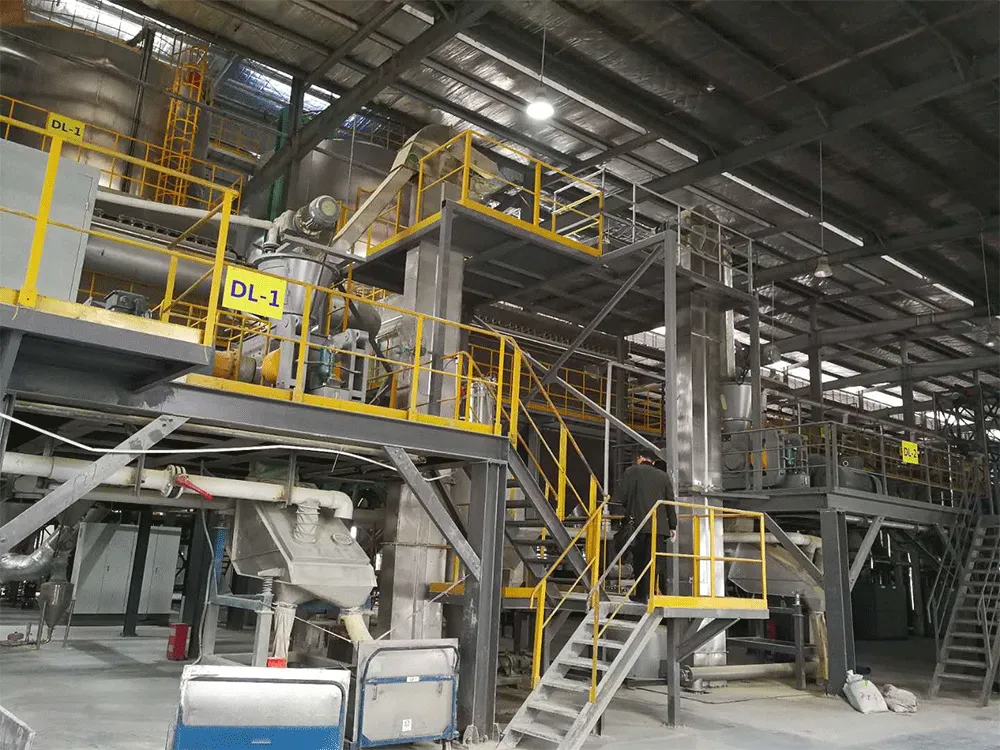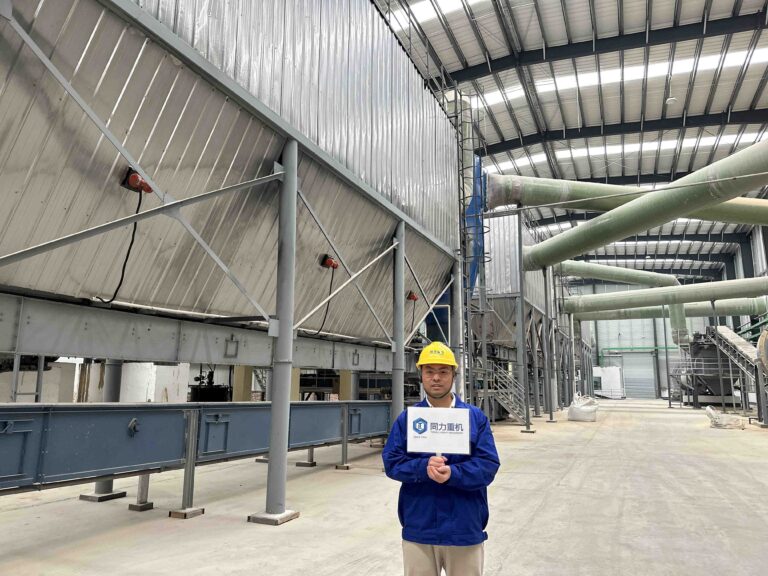Roller Press Irregular briquetting
Granulation line
The process of shaped pellets is to extrude the material into large pieces, and then through the crusher to crush the large pieces of material to the size of the finished product, the strength of the particles is higher than the round particles.
Briquetting dry granulation line equipment List

Automatic dosage systems
- Hopper: To store and feed raw materials.
- Conveyor: To transport raw materials to the briquetting granulator.
- Electric belt scale: Automatically batch the raw material

Briquetting & compaction machine
- Roller compactor: To compact the raw material into dense sheets or flakes.

Crushing System
- Pre-crusher: To crush the flakes into small particles.
- Crusher: To break down the product into the desired particle size.

Sieving system
- Vibrating Screen: To separate granules of different sizes and ensure uniformity.
- Rotary Screener: Less dust compare to the vibrate screener. Better technology.

Product handling system
- Rotary drum polishing machine: Make the irregular granule into rounded shape.
- Rotary drum coating machine: Apply coating to the product.

Auxiliary Equipment:
- Packing Machine: To package the final granules into bags.
- Conveyor system: Belt conveyor/bucket elevator/screw conveyor.
- Dedusting system: Bag filter/ centrifugal blower
compaction fertilizer granulating line technical parameters
| Product Name | Capacity (t/h) | Power (kw) | Dimension (mm) |
|---|---|---|---|
| Dynamic Batching Machine | 1-20 | 1.1×4 | 1500×1500 |
| Cage Crusher | 6-10 | 15×2 | 1500×1500×1500 |
| Double Shaft Mixer | 1-20 | 22 | 6200×1300×1200 |
| Double Roller Extrusion Granulator | 1.5 | 18.5 | 1450×850×1500 |
| Disc Feeder | 2-4 | 7.5 | 1600×1600×1800 |
| Rotary Screening Machine | 1-2 | 3 | 3950×1720×2100 |
| Automatic Packing Scale | 6bags/min | 0.55+0.37 | 720×630×1980 |
Raw materials for Roller Press Irregular Granule Extrusion line
Fertilizer field
The Roller Press Irregular Granule Extrusion line requires a small footprint, so if your goal is only to produce 3 tons of granules per hour, then this machine may be perfect for you. In addition, this line has a target capacity of 30-60 tons per day, which equates to 9,000 to 20,000 tons per year, making it suitable for small to medium-sized plants.
Industrial field
This production line includes operating channels, auxiliary facilities (such as offices, warehouses, maintenance areas, finished product storage facilities) and necessary safety distances. Therefore, for the actual setting of a 3-ton per hour extrusion granulation small production line, approximately 550 square meters of land is required.
Mineral powder:
Inorganic fertilizers include potassium chloride (KCL), potassium sulfate (SOP), ammonium sulfate (AS), NPK, etc. Industrial byproducts such as desulfurized gypsum (FGD gypsum) and steel slag are also widely used. Compound organic fertilizers include coconut bran, charcoal, humic acid, animal manure containing NPK, and rice straw containing NPK.
Chemical powder
These raw materials are used for extrusion granulation to produce a variety of products, including snow melting agents, combustion improvers, slag removers, flame retardants, cement retarders, fluorescent agents, battery powders and ceramics, etc. These products have a wide range of application values in different fields.
Mineral powder:
Gypsum, limestone, zeolite, ulexite, lime, coal, dolomite, bentonite, diatomite, bauxite, etc.
Roller Press Irregular Granule Extrusion line Production Process
This irregular large particle briquetting extrusion granulation is more suitable for raw materials containing metal elements, such as potassium chloride(KCL) and potassium sulfate(H2SO4) fertilizer production. The use of conventional roller extrusion granulator will result in a large consumption of stainless steel roller skins because these raw materials contain metal substances. Therefore, for raw materials containing metal elements, we usually recommend this large particle extrusion method. Its advantages are less wear and greater output. Compared with the compound fertilizer drum granulation production line, this large particle extrusion method can also handle single-element fertilizers with insufficient viscosity. The raw materials are squeezed into particles by the pressure between the two rollers, which can greatly improve the ball formation rate.
Whether you need an automatic quantitative batching system for raw materials depends mainly on the type of products you produce. If you only produce single-element fertilizers, such as potassium chloride or potassium sulfate, you do not need batching. However, if you want to produce npk compound fertilizers in addition to these two single-element fertilizers, you will need a variety of raw materials. Therefore, when producing npk compound fertilizers, you need to equip the corresponding number of high-precision batching scales according to the type and quantity of raw materials to weigh the raw materials before entering the subsequent mixing process.
After the raw material is weighed, it goes into the twin-shaft mixer for mixing and conveying. The main function of the mixer is to make the raw material composition more uniform and to handle the return material from the screening process such as the drum screen or vibrating screen. The unqualified materials after screening will be returned to the mixer through the return belt or return scraper for re-mixing. In the mixer, we also add a water pipe to ensure that the moisture content of the raw material is kept at around 2% before it can enter the subsequent extrusion process. This can improve the overall efficiency, because without the proper moisture content, the ball formation rate cannot be guaranteed.
When these raw materials are processed, they will enter the large-particle extrusion granulator through the feeding system. Compared with the conventional small-particle extruder, our large-particle extruder has a higher output of up to ten tons per hour. The pellets produced are stronger because the two rollers are pressurized by the oil cylinder, and the materials are squeezed into strips or blocks in two stainless steel molds. The specific shape is determined by the texture on the mold. The finished product then enters the next crushing process.
After the material is extruded, its strength is already very high. Next, we need to proceed to the second step of processing. Since the extruded material is in the form of strips or blocks, with a size of approximately three to five centimeters, it is necessary to break the large blocks into smaller pieces. We use an impact crusher for crushing, and it is divided into two processes: the first is pre-crushing, and the second is formal crushing. The impact crusher uses a rotating hammer to break the extruded compound fertilizer strip material into blocks. After pre-crushing, the block material size is one to two centimeters, and after the second crushing, the size is 0.5 to 0.7 centimeters, forming small particles. These small particles will enter the screening equipment for screening, and unqualified products will be returned for processing.
Screening is an important part of the whole production line, because the process of large particle crushing is relatively short, mainly including granulation, screening and crushing. After the first hammer crushing, the material will enter the drum screen or vibrating screen. Qualified particles enter the secondary crushing, and unqualified particles are returned to the twin-shaft mixer for reprocessing. After the second crushing, the finished product screening, also called fine screening, is carried out. The qualified finished products screened out directly enter the next step, and the unqualified particles are returned to the twin-shaft mixer for re-granulation.
The next step is the polishing process, which mainly depends on the needs of the customer. Some customers do not like compound fertilizers with irregular particles, so they need to make them as round as possible. At this time, it is necessary to use a rotating polishing and shaping equipment to process the surface of the particles. If the customer can accept irregular particles and think there is no problem, then this process is dispensable and mainly serves the purpose of aesthetics.
The coating process is determined by customer needs. The screened materials will enter the automatic quantitative feeding scale and feeding belt scale. According to the feeding amount, coating oil and anti-cleaning agent will be added through the DCS system. Whether to coat depends mainly on customer needs. If the customer wants the particles to be brighter in color, enhancing product stability, or wants to extend the storage time of the fertilizer, then coating is required. If there are no special requirements, this process can be omitted in order to save costs.
Our dust removal system is equipped with a bag filter, which we recommend because the local dust humidity content is not high. The system is equipped with a centrifugal fan and a fiberglass chimney, which can effectively collect dust from the raw material feeding part and the screening process, and control the emission below the standard of 30 mg per cubic centimeter.
Finally, we have an automatic quantitative packaging scale and a fully automatic APP robot palletizing system, which is mainly used to pack the finished products. We can pack the finished products into 25 kg or 50 kg bags. The palletizing robot system includes a full stainless steel conveyor belt machine and robot gripper, and the output can reach 1,000 bags per hour, which is a relatively regular output. Our automatic packaging scale uses advanced servo motor technology and the output is also between 800 and 1,000 bags per hour.

Roller Press Irregular Granule Extrusion Line Advantages
- The investment of extrusion pelletizing equipment is medium.
- Small footprint of extrusion pelletizing equipment.
- Extrusion pelletizing equipment is flexible.
- Easy installation of extrusion pelletizing equipment.
- Extrusion pelletizing equipment has low requirements for operators.
- Note: For high moisture, high phosphorus content materials or organic and inorganic compound fertilizer can not be used in this pelletizing method, otherwise the material will stick to the machine.




Project Case 2024
- In the past year, Tongli EPC has undertaken more than 5 briquet-ting extrusion granulation compound fertilizer production lines, among which 12 large-particle extrusion granulation lines in Belarus are our landmark projects.
- Our extrusion compaction granulator is mainly used in the compound fertilizer industry. Potassium sulfate and potassium chloride granulation lines are popular in Central Asia. Our extrusion granulator can also adapt to other raw materials such as Gypsum, limestone, zeolite, ulexite, lime, coal, dolomite, bentonite, diatomite, bauxite, etc.










